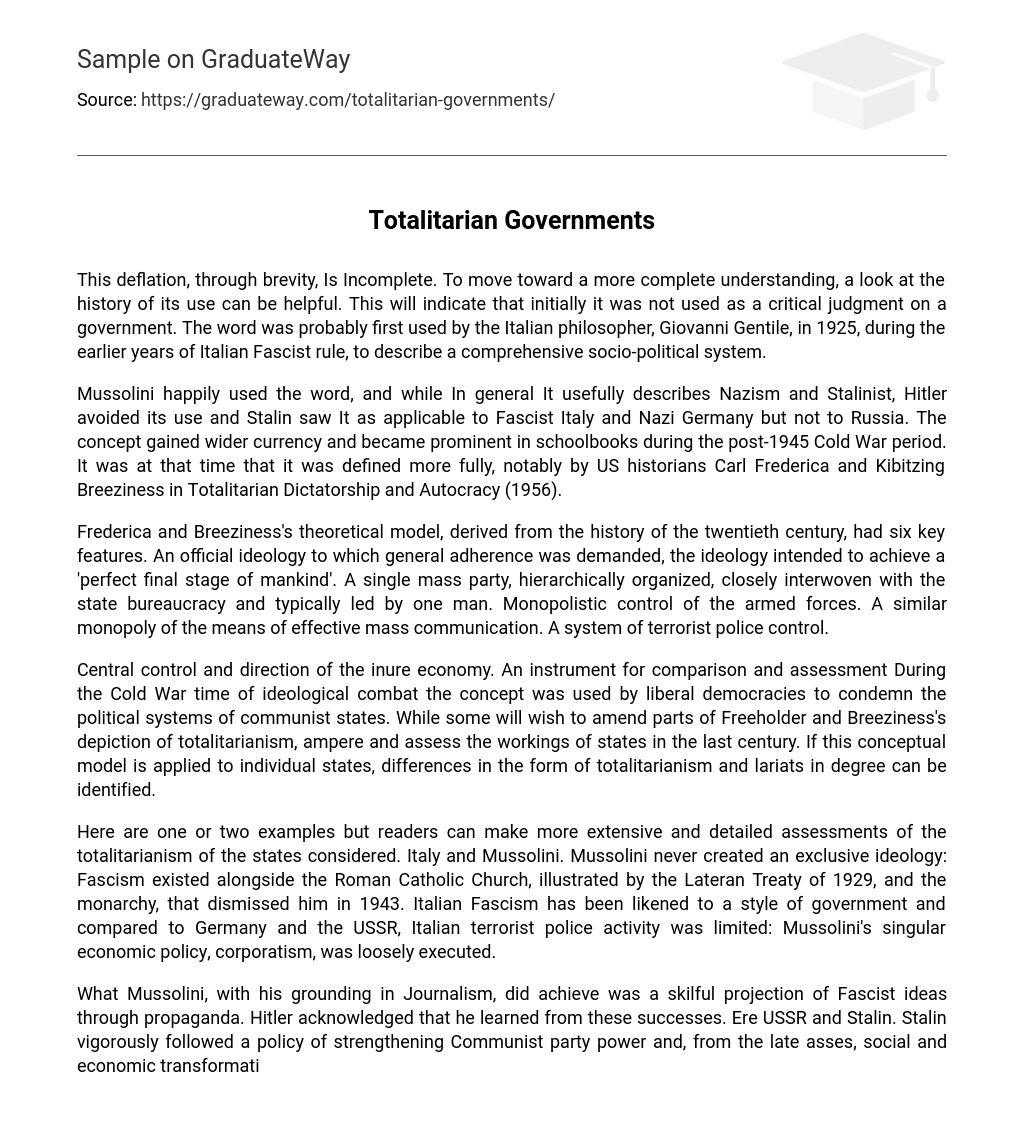This deflation, through brevity, Is Incomplete. To move toward a more complete understanding, a look at the history of its use can be helpful. This will indicate that initially it was not used as a critical judgment on a government. The word was probably first used by the Italian philosopher, Giovanni Gentile, in 1925, during the earlier years of Italian Fascist rule, to describe a comprehensive socio-political system.
Mussolini happily used the word, and while In general It usefully describes Nazism and Stalinist, Hitler avoided its use and Stalin saw It as applicable to Fascist Italy and Nazi Germany but not to Russia. The concept gained wider currency and became prominent in schoolbooks during the post-1945 Cold War period. It was at that time that it was defined more fully, notably by US historians Carl Frederica and Kibitzing Breeziness in Totalitarian Dictatorship and Autocracy (1956).
Frederica and Breeziness’s theoretical model, derived from the history of the twentieth century, had six key features. An official ideology to which general adherence was demanded, the ideology intended to achieve a ‘perfect final stage of mankind’. A single mass party, hierarchically organized, closely interwoven with the state bureaucracy and typically led by one man. Monopolistic control of the armed forces. A similar monopoly of the means of effective mass communication. A system of terrorist police control.
Central control and direction of the inure economy. An instrument for comparison and assessment During the Cold War time of ideological combat the concept was used by liberal democracies to condemn the political systems of communist states. While some will wish to amend parts of Freeholder and Breeziness’s depiction of totalitarianism, ampere and assess the workings of states in the last century. If this conceptual model is applied to individual states, differences in the form of totalitarianism and lariats in degree can be identified.
Here are one or two examples but readers can make more extensive and detailed assessments of the totalitarianism of the states considered. Italy and Mussolini. Mussolini never created an exclusive ideology: Fascism existed alongside the Roman Catholic Church, illustrated by the Lateran Treaty of 1929, and the monarchy, that dismissed him in 1943. Italian Fascism has been likened to a style of government and compared to Germany and the USSR, Italian terrorist police activity was limited: Mussolini’s singular economic policy, corporatism, was loosely executed.
What Mussolini, with his grounding in Journalism, did achieve was a skilful projection of Fascist ideas through propaganda. Hitler acknowledged that he learned from these successes. Ere USSR and Stalin. Stalin vigorously followed a policy of strengthening Communist party power and, from the late asses, social and economic transformation but how ar this can be seen as ideologically Marxist-Leninist policy continues to be debated among historians, as discussed by Jane Redford in this issue. Ere Third Reich and Hitler.
When Hitler gained power he had already promoted a strongly nationalist/ racist ideology for some time, not least in his prison book, Mien Kampala (1923), and he, with Dry Joseph Gobbles were outstanding practitioners of the use of mass communication, but Hitter’s control of the armed forces, with their embedded Prussian officer corps mentality, took some time to achieve. Effective intro of the entire economy (see the concept article, ‘Economic tetrarch’) required a struggle and was successful only midway through the Second World War.
Edgar Effectuating has described the policy of Magnification, in his concise ‘Challenging’ concept article and, in the next issue, David Welch charts the party/state administrative muddle in the Third Reich. Democracy and totalitarianism This writer has proposed elsewhere (The Good History Students’ Handbook, 1993) that liberal democracy can develop only where certain circumstances exist. These include agree of industrialization, an active media and expressions and discussions of opinion.
Also needed are attitudes, held in common within society, of tolerance, respect for minority and individual rights and the absence of fixed goals. Alert readers will note that a totalitarian system uses the same circumstances needed for liberal democracy and, harnessed to a fixed goal, acts to negate or reverse the attitudes that underpin democracy. Twentieth-century technology has provided the possibilities for the use of media (newspapers, radio, film and television) to Iranians’ citizens, and modern communications to identify dissidents and co- ordinate action against them.
It is inconceivable that a person in their right mind would wish to loose two of democracy greatest gifts, pluralism (a plurality of power centers) and the rule of law. It is noteworthy, therefore, that the roots of totalitarianism have been traced to the asses, thought by many to be the high point of liberalism. Liberalism, with its emphasis on individual liberty, contained a contradiction. Unrestrained pursuit of individual liberty was a threat to others, that is to the society, without which individual liberty was worthless.
With their stress on the social rather than the Individual, the three main totalitarian systems mentioned and other lesser systems, in their own crudely inhuman ways redressed this contradiction. If this latter view unsettles readers, then this last will do so more. It has been suggested by some thinkers that liberal democracies have totalitarian characteristics in the sense that the assumptions of capitalism, and the appropriate way of life, are remorselessly inferred in all that is public and creates a homogeneities mind set among the population.





